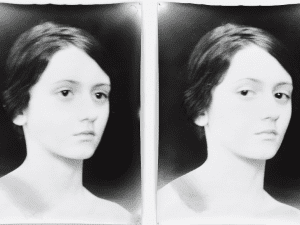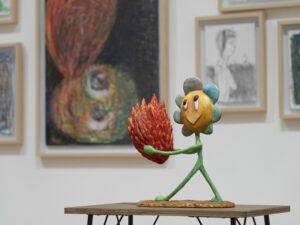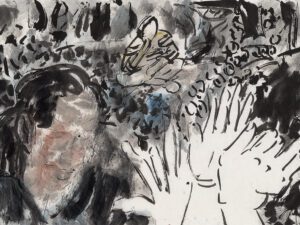Oakland, California-based Jean Davis paints abstracted figures placed in ambiguous settings. Her work focuses on themes of the impermanence of place and the uncertainty of our perceptions.
A: Why do you think that figurative abstraction is such an interesting genre to work within, and how it is still relevant within today’s society as a form of cultural expression?
JD: Figurative abstraction allows me to move away from modelling what I see and let some of my subconscious show through in the abstract marks. The figure is the subject, the vehicle with which to start a visual conversation between the painting and the viewer. I intentionally relinquish control over the outcome by introducing the abstract elements to each composition, and that’s what I think allows the communication to go deeper and get more personal. It allows me to be less guarded, and to possibly reveal what I am unaware of, or something I am less confident about revealing. It helps me to keep my marks raw, and honest – less calculated, which is something I value.
I don’t think that people will ever completely tire of the figure. It may be expressed differently from one generation or movement to another, but as a subject it’s instantly relatable. Abstracting the figure adds emotion, makes it less exalted – both as an art form and as a subject. In graffiti, political art, or simply as an aesthetic component, abstracting the figure widens its use as a means of expressing ideas and emotions beyond being a portrayal of what is seen, or a moment in time. I see a sense of irreverence in the abstraction. A portrait or self-portrait contains a more complex psychological narrative when the face is, for example, distorted or strangely coloured. The narcissism of the individual (either subject or artist) is removed. It is the person living in the body, rather than the appearance of the body, that matters. I think this enables an artist to paint more powerful visual messages pertaining to life, politics, and society in general.
A: Who or what are you most inspired by?
JD: I am inspired by nature – the ocean crashing, a snow-covered forest, or a storm that I can watch from a sheltered place. But I don’t paint these things – they occupy my mind while I observe or spend time with them. This frees me from regular thought and allows my imagination to go to work.
A: How do you think that context ultimately affects the types of work that you produce, for example, how your work and domestic life feed into one another?
JD: I think context has a strong effect on the work I produce. Context is present in the ideas behind the work, the motivation for making a particular body of paintings. Transformation and Emergence were both about the grieving process (in different stages) but were not meant to portray grief necessarily. The abstractions were ways to express what words could not. It’s almost impossible for me to remove context from my work – the pieces that I am currently working on are also strongly influenced by recent events and experiences in my personal life. Context is there whether I want it to be or not. But it rarely presents itself fully as representation or actual narrative.
A: You have recently returned from a residency in Finland – how did your time in the country influence your latest pieces?
JD: Since I’ve returned, my work has been based on new subject matter, and I’m using a different palette. I expected to be influenced by the light and colour of the shorter days, but was not expecting the other influences I now notice. My colours are bolder, darker and more earth-toned; although so far I’m using limited palettes. My subject matter involves elements of nature (while still being figurative), which is a departure. I was drawn to the contrasts I saw while there – an intensely blue sky with white snow, stars in a dark sky (without light pollution), red-painted houses among dark green foliage and snow – as well as to the visual differences between that environment and where I live now. My latest pieces are more narrative than before, somewhat less abstract, and more expressive. I was inspired by the beauty of the countryside and the forest, and have pulled some of that into the work that I am doing now.
A: How do you think that the environment is reflected within your pieces, in terms of capturing the sensory aspects of light and colour?
JD: The colours I use in the abstracted elements of my compositions reflect the light and colours of the California environment, as I perceive it. The sky here is almost always blue and filled with soft sunlight year round. The climate is mild and I think my colour choices reflect that – I tend to use light, pastel, or muted yellows, blues, and greys, rather than very bright or very dark hues. (I live in coastal northern California. Southern California has a warmer, sunnier climate that I think would have shown in my work through brighter, bolder palettes.) I try to bring the feeling of calm that I see in my surroundings into the abstracted settings of my work, rather than painting actual object-based settings such as rooms or buildings.
A: What do you have planned in terms of future projects?
JD: I am currently focused on building the body of work I started this winter, based on my impressions of the light and colours in southern Finland. It’s a slight departure for me, as it is less abstract in style than most of the work I’ve done so far. I also plan to travel to do research for developing this project, and for getting ideas and material for the body of work to follow it.
Credits:
1. Jean Davis, Emergence. Courtesy of the artist.





